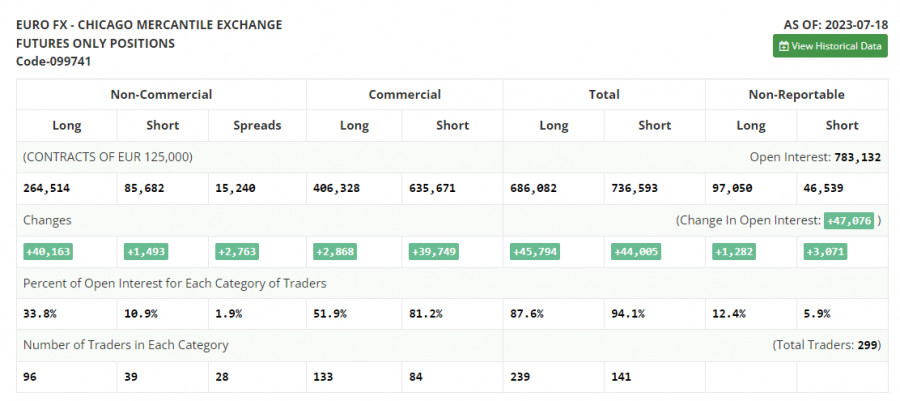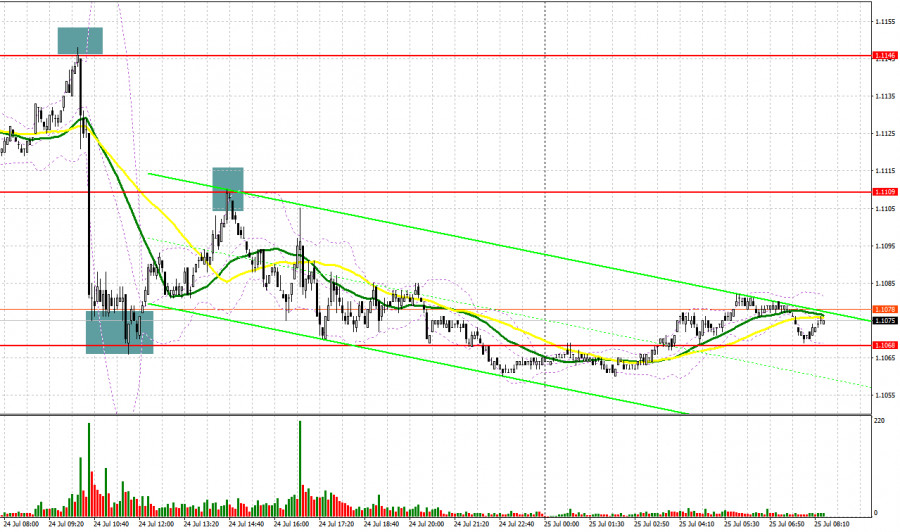
Yesterday, the instrument formed several excellent market entry signals. I suggest we take a look at the 5-minute chart and figure out what happened. In my previous forecast, I paid attention to the level of 1.1149 and recommended adjusting your decisions on market entry to this level. Growth and false breakdown at 1.1149 after disappointing Eurozone PMIs generated a sell signal. As a result, the price fell by more than 50 pips. Support protection and a false break at 1.1078 provided a buy signal with a move of about 40 points up. In the afternoon, the protection of 1.1109 and a false break allowed us to get another entry point for short positions, which enabled another fall by more than 40 pips.

What is needed to open long positions on EUR/USD
Before talking about the further prospects of the EUR/USD movement, let's discuss what happened in the futures market and how the positions of the COT report have changed. In the COT report (Commitment of Traders) for July 18, there was an increase in both long and short positions. However, there were much more buyers, which strengthened the balance of trading forces in the market in their favor. The data on the US inflation triggered buying of risky assets, including the euro. Last week, ECB policymakers stated that it would be the right time to step up with a hawkish policy in the Eurozone. Such prospects only cemented expectations and bets on further growth of the euro against the US dollar. The Federal Open Market Committee will meet this week to decide on monetary policy. Many economists expect them to announce the last rate hike in a nearly 1.5-year cycle of monetary tightening. Such prospects will further weaken the dollar. The ECB meeting is likely to be hawkish. For this reason, while the market is bullish, buying the euro on dips remains the optimal medium-term strategy. The COT report shows that long non-commercial positions rose by 40,163 to 264,514, while short non-commercial positions grew only by 1,493 to 85,682. At the end of the week, the total non-commercial net position rose to 178,000 from 140,162. EUR/USD closed last week higher at 1.1300 versus 1.1037 a week ago.

Today, in the first half of the day, important statistics on Germany are released, which can weaken the position of the European currency even more. Traders will get to know reports on the German Business Expectations Index, the Business Environment Indicator, and the IFO Current Situation Indicator. Forward-looking data will be much more interesting than the current sentiment. A decline of the indicator will lead to the fall of the euro back to the area of the weekly low of 1.1062, from which I am going to enter the market. A false breakout there will give a signal to buy, allowing the instrument to return to growth and reach a rather large resistance level of 1.1106, which it failed to get above yesterday. There are also moving averages that play on the side of the sellers. A break and test from top to bottom of this range will boost the demand for the euro, giving it a chance to climb as high as 1.1146. The area of 1.1188 remains the highest target, which will indicate the development of a new uptrend. I will take profit there.
With the option of EUR/USD decrease and the absence of buyers at 1.1062, the bears may continue to trade more actively, relying on a downward correction. Therefore, only a false breakout in the area of the next support at 1.1015, by analogy with what I analyzed above, will give a signal to buy the euro. I will open long positions immediately on a dip from the low of 1.0981 with the aim of an upward correction of 30-35 pips intraday.
What is needed to open short positions on EUR/USD
Given that the bears continue to assert their strength, the chances for a downward correction are still valid, especially in the case of disappointing reports from Germany, whose economy has recently been facing serious problems. The sellers can count on resistance at 1.1106, which performed well yesterday afternoon. Defending this level will be a priority. If the instrument fails to consolidate there, similar to what I discussed above, this will provide a sell signal that can push EUR/USD to 1.1062. A lot depends on this level since the return of the pair under it can lead to the demolition of stop orders for many traders. Fixation below this range, as well as a reverse test from the bottom up, opens the way to 1.1015. The lowest target will be at least 1.0981, where I will take profits. If EUR/USD moves up during the European session and there are no bears at 1.1106, the situation will return under the buyers' control. In this case, I will postpone short positions until the next resistance at 1.1146. You can also sell there, but only after an unsuccessful consolidation. I will open short positions immediately on a bounce from the high of 1.1188 with the aim of a downward correction of 30-35 pips.
Indicators' signals
Moving Averages
The instrument is trading below the 30 and 50-day moving averages. It indicates further weakness of the euro.
Note: The period and prices of the moving averages are considered by the analyst on the 1-hour chart and differ from the general definition of classic daily moving averages on the daily chart.
Bollinger Bands
In case EUR/USD extends its decline, the indicator's lower border around 1.1060 will act as support. Otherwise, the upper border at 1.1095 will serve as support.
Description of indicators
Moving average (moving average, determines the current trend by smoothing out volatility and noise). Period 50. It is marked yellow on the chart. Moving average (moving average, determines the current trend by smoothing out volatility and noise). Period 30. It is marked green on the chart. MACD indicator (Moving Average Convergence/Divergence — convergence/divergence of moving averages) Quick EMA period 12. Slow EMA period to 26. SMA period 9 Bollinger Bands (Bollinger Bands). Period 20 Non-commercial speculative traders, such as individual traders, hedge funds, and large institutions that use the futures market for speculative purposes and meet certain requirements. Long non-commercial positions represent the total long open position of non-commercial traders. Short non-commercial positions represent the total short open position of non-commercial traders. Total non-commercial net position is the difference between short and long positions of non-commercial traders.